Project background
Hawksbill sea turtles are critically-endangered throughout their range. This species has been harvested for centuries to feed demand for its beautiful shell, referred to as tortoiseshell, which is used to make jewelry, souvenirs and other decorative items. Hawksbills utilize coral reef habitats and were once very abundant throughout the Caribbean. Sustained harvesting has reduced their numbers by more than 95 percent. However, long-term conservation efforts are beginning to show promising results. Unfortunately, many small Caribbean island nations still allow the legal harvesting of this species, despite an international ban on all trade of products made from hawksbills.
For the last 10 years, Sea Turtle Conservancy (STC) has been working with local communities to monitor and protect a small but growing population of hawksbills in the West Indies, particularly in Nevis and neighbouring islands. For generations, Nevisians and other local people of the Caribbean have used sea turtles in an unsustainable manner. Reversing this tradition will take a sustained effort to change attitudes and behaviour. It will also take efforts to replace the income generated by harvesting turtles with sustainable activities such as ecotourism.
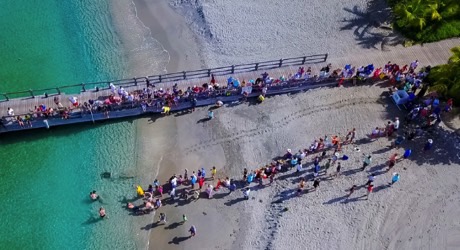
This project is addressing a variety of critical needs by:
- continuing to monitor the turtle population and collect vital information about its movement between islands;
- raising awareness about the species and its threats among communities throughout the West Indies;
- involving young people in the project in order to increase conservation stewardship; and
- promoting ecotourism in the very communities where it is needed to replace the harvesting of sea turtles.
Project activities
This project was carried out during a 12-month period in the Caribbean West Indies, particularly within the region of St. Kitts and Nevis. Financial support from the Footprints Network provided essential resources to carry out a program with the following primary goals:
Goal #1: Conduct sea turtle monitoring and conservation activities in the West Indies in close coordination with local community members.
Goal #2: Use satellite-telemetry to track the migratory behaviour of hawksbills nesting in the West Indies and use that information to support an environmental education program.
Goal #3: Promote sea turtle eco-tourism as an alternative to the harvesting of sea turtles and as a way to build sustainable conservation programs that provide revenue for local communities.
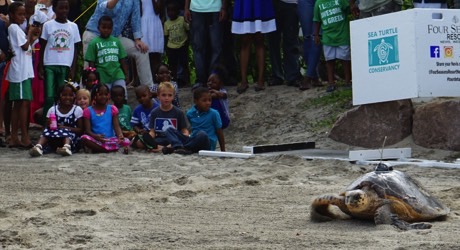
Project results
Goal #1
During the 2019 sea turtle nesting season, Sea Turtle Conservancy (STC) successfully continued its 13-year partnership with the Nevis Turtle Group, a community-based sea turtle nesting monitoring program on the island of Nevis in the West Indies.
Each year, STC works with the local Four Seasons hotel and the Nevis Turtle Group to host guided turtle walks for guests, an educational camp for local children, and a public sea turtle release of satellite-tagged turtles. The Nevis Turtle Group continued its growing nest monitoring program on the island, with assistance from STC in the form of financial support, field and educational supplies and opportunities to assist with our satellite telemetry project. STC conducted on-site education and outreach activities in association with its satellite tagging program in the summer of 2019.
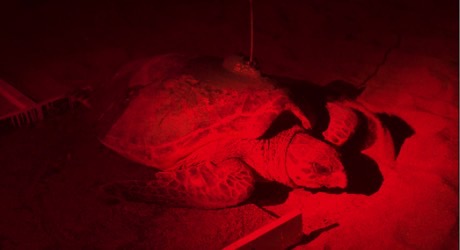
During this reporting period, community members conducted night and morning surveys on three nesting beaches in Nevis: Lovers Beach, Cades Bay and Jones Bay. In total, these three beaches produce over 200 sea turtle nests per year and new major nesting beaches are in the process of being identified. The Nevis Turtle Group is comprised of local Nevisian people, including teenagers and young adults.
This year, members of the group assisted STC’s researchers with attaching the satellite transmitters to Patches and Spongie – two hawksbill sea turtles that joined the Tour de Turtles migration marathon. By learning these cutting edge sea turtle research techniques, local members of the Nevis Turtle Group will be equipped with the tools to protect their local sea turtle populations and habitats well into the future.
Goal #2
In July 2019, STC satellite-tagged two critically endangered hawksbill sea turtles, Spongie and Patches, with the help of members of the Nevis Turtle Group. STC and Nevis Turtle Group members encountered the nesting hawksbills on Cades Bay, a beach on Nevis Island that receives around 50 nests per year. After each turtle completed nesting, staff briefly held the turtles in a four-walled box, cleaned their shells and placed satellite transmitters on each turtle before releasing them back to sea. During the satellite attachment process, Nevis Turtle Group volunteers also recorded biometric data on each turtle for research. Once the turtles were released, their movements were able to be tracked online through STC’s website and the turtles officially joined the Tour de Turtles program.
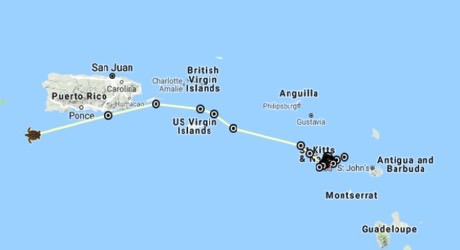
STC learned that both turtles nested again after being satellite-tagged, which indicates that the turtles are healthy and are unimpeded by their satellite transmitters. After nesting, both turtles took different migratory paths to find foraging grounds. Patches (tracking map pictured above) stayed close to the surrounding waters of Nevis until the beginning of September, where she started a trek west to her current location – near Puerto Rico. Spongie (tracking map pictured below) also remained close to Nevis until the end of August, when she began to head due south until settling at a foraging ground just north of Grenada. Only one other hawksbill STC has tagged in Nevis has traveled further south than Spongie.
Through STC’s Tour de Turtles program, which reached its 12th year in 2019, STC’s scientists, the public, beach monitors and policymakers were able to view sea turtle migratory paths that were once completely unknown. By making this information available to the public, STC allowed for communities in neighboring West Indies learn about how their local sea turtles move between islands. With this information, scientists and lawmakers in Nevis will have the ability to predict and prevent potential human impacts on the region’s hawksbill sea turtles. STC also began work on a scientific publication that will include satellite telemetry data from Nevis hawksbills, which will ultimately be shared with the scientific community, the public, and policy makers who can enact laws to protect important migratory corridors.
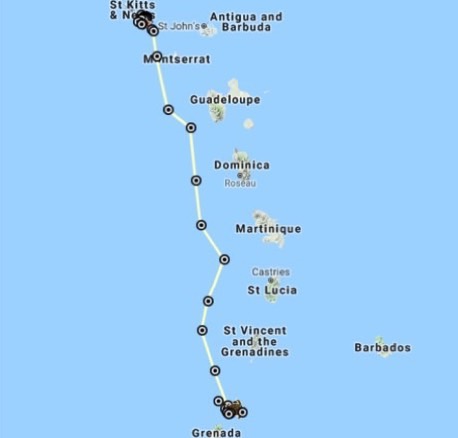
Goal #3
Hunted nearly to extinction for their unique shells used to make tortoiseshell jewelry and trinkets, hawksbill sea turtles are in need of urgent conservation efforts throughout communities in the Caribbean. In Nevis, a legal harvest of sea turtles still exists at certain times of the year, and though poaching of turtle eggs and nesting females is illegal, there is insufficient enforcement of the existing laws.
This year, STC and the Nevis Turtle Group redoubled their efforts to stop the poaching of nesting sea turtles. The project’s presence on sea turtle nesting beaches acted as a deterrent to poaching in itself, but members of the group also used tactics such as erasing turtle tracks in the sand to conceal nest locations. Additionally, project staff actively communicated with the Nevis fishery’s governing body regarding the potential removal of the legal harvest and will continue to educate the group on the impact the legal harvest has on the region’s sea turtle populations.
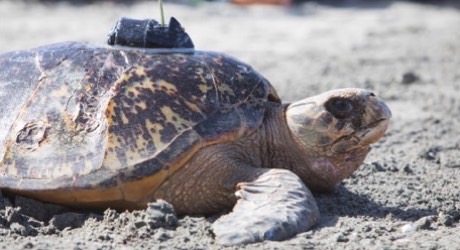
In association with the Four Seasons Resort – Nevis and the Tourism Ministry of Nevis, STC and its project partners continued to promote eco-tourism to this and other island nations in the Caribbean as a sustainable alternative to the harvest of sea turtles by hosting guided Turtle Walks, educational presentations for hotel staff and guests, and a sea turtle camp for children. By empowering the local community to monitor and protect sea turtle populations, decrease poaching and recognize the value of using turtles as ecotourism, STC’s stewardship program in Nevis helped to improve sea turtle survival in the region.
What next?
STC will continue to sustain and help to expand upon the work of local communities in Nevis to monitor and protect local sea turtle populations. The sea turtles in this region are under immense pressure from poaching and legal harvest, and STC intends to continue building conservation capacity in this region to ensure that its sea turtles survive well into the future.
Project Background
Hawksbill sea turtles are critically-endangered throughout their range. This species has been harvested for centuries to feed demand for its beautiful shell, referred to as tortoiseshell, which is used to make jewelry, souvenirs and other decorative items. Hawksbills utilize coral reef habitats and were once very abundant throughout the Caribbean. Sustained harvesting has reduced their numbers by more than 95 percent; however, long-term conservation efforts are beginning to show promising results. Unfortunately, many small Caribbean island nations still allow the legal harvesting of this species, despite an international ban on all trade of products made from hawksbills.
For the last 10 years, Sea Turtle Conservancy (STC) has been working with local communities to monitor and protect a small but growing population of hawksbills in the West Indies, particularly in Nevis and neighbouring islands. For generations, Nevisians and other local people of the Caribbean have used sea turtles in an unsustainable manner. Reversing this tradition will take a sustained effort to change attitudes and behaviour. It will also take efforts to replace the income generated by harvesting turtles with sustainable activities such as ecotourism.
This project is addressing a variety of critical needs by continuing to monitor the turtle population and collect vital information about its movement between islands; raising awareness about the species and its threats among communities throughout the West Indies; involving young people in the project in order to increase conservation stewardship; and promoting ecotourism in the very communities where it is needed to replace the harvesting of sea turtles.
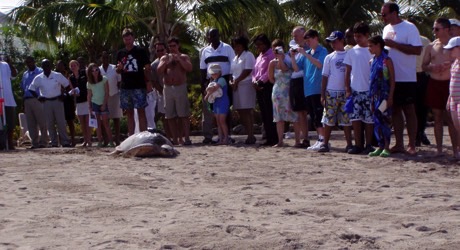
Project Objective
The overall project objective is to support the protection and recovery of endangered hawksbill sea turtles in the cluster of Western Caribbean islands that makeup the West Indies. Particular attention will be given to the island of Nevis, where a small but growing population of hawksbill turtles needs further study and protection from a variety of threats.
In addition to the collection of important biological information about this population of turtles, the project will support training and stewardship activities that involve young people from the local community. It is still legal to harvest sea turtles in some small Caribbean nations; this project will advance efforts to put legal protections in place for all sea turtle species in the region in order to replace the harvesting of sea turtles with sustainable eco-tourism.
Project Aims
- Conduct sea turtle monitoring and conservation activities in the West Indies in close coordination with local community members.
- Use satellite-telemetry to track the migratory behaviour of hawksbills nesting in the West Indies and use that information to support an environmental education program.
- Promote sea turtle eco-tourism as an alternative to the harvesting of sea turtles and as a way to build sustainable conservation programs that provide revenue for local communities.
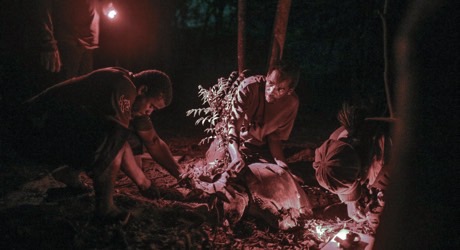
Project Outcomes
- A nest monitoring program will be carried out in partnership with local community members in order to involve young people in the collection of important data about sea turtle nesting trends.
- At least two critically-endangered hawksbills will be tracked using satellite telemetry to further our understanding of the migratory behaviour of this species in the West Indies.
- Information about migratory movements will be shared with communities in neighbouring islands to foster greater understanding about sea turtles move between islands and are impacted by laws and human behaviour in each location.
- Sustainable eco-tourism will be promoted as an alternative to the unsustainable harvesting of sea turtles. NOTE: There will be opportunities for turtle enthusiasts to assist hands-on with sea turtle conservation at this project location.
What is Covered in Project Costs
The total budget for this project is $50,000. These costs include salaries for the project’s lead biologist, research supplies and equipment (including satellite transmitters for tracking turtles), direct support for local community members who assist with nest monitoring, transportation for project staff to visit various islands, lodging and meals during travel and supplies for community outreach and education activities. STC is seeking $25,000 through this campaign. The remainder of the project budget will be raised from other sources. Project costs will be spread across the below activities:
- Salary for Lead Project Biologist
- Research supplies (including satellite transmitters)
- Support for local community beach monitors
- Transportation
- Lodging and meals
- Education program supplies

Project Partners and Community Involvement
This project is carried out in close collaboration with local volunteer community members that have organized as the Nevis Turtle Group. STC directly supports this group’s activities with financial support, field supplies and opportunities to participate in cutting-edge satellite telemetry research. The project also offers opportunities for community members to generate income from eco-tourism through the hosting of guided walks to observe sea turtles nesting in their natural habitat. Additional partnerships have been formed with local hotels and resorts, which support the project by minimizing their impacts on the nesting beach and by hosting environmental education programs such as the project’s annual sea turtle summer camp for local school kids.
Part of a Larger Strategy
For nearly 60 years, STC has conducted sea turtle research and protection in the Caribbean and Central America. This project fits well with the organization’s long-term strategies and goals for sea turtle recovery. All sea turtle species face considerable threats from poaching, habitat disturbance, marine pollution and interaction with fisheries. These threats are especially prevalent in the Caribbean.
In order to systematically improve sea turtle survival, STC must play a key role in collecting important data about sea turtles; training tomorrow’s conservation leaders; and raising broad awareness about threats to sea turtles. This program will help accomplish all these goals.